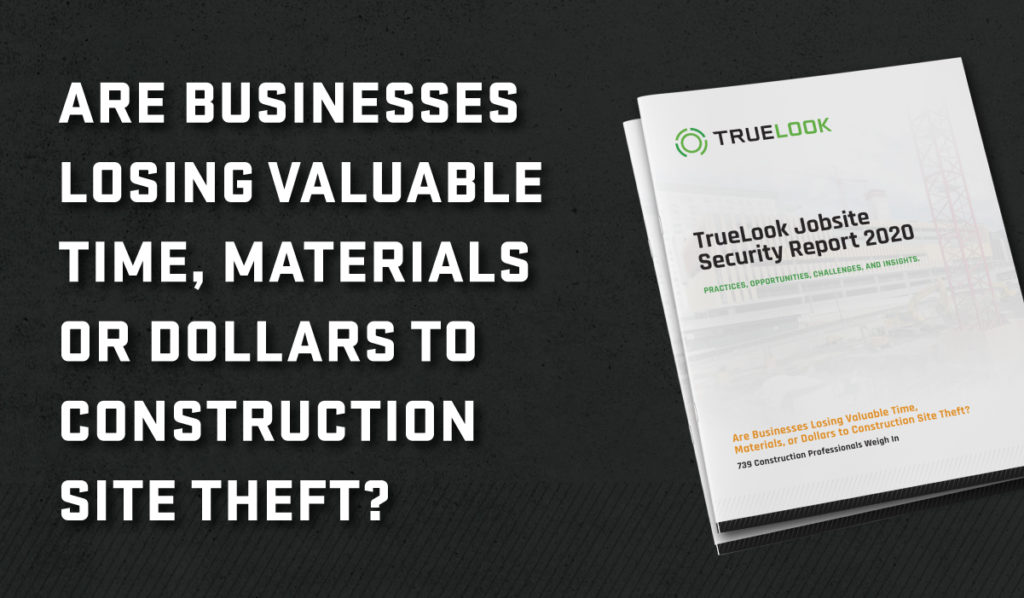
According to the National Equipment Register, construction jobsite theft costs the industry up to $1 billion each year. Thieves make away with a variety of heavy equipment, as well as tools and materials that are left unattended. Truelook recently conducted a Jobsite Security Survey of 739 construction project managers, supervisors, tradesmen and site foremen to gauge how construction firms are using cameras to deter and prevent jobsite theft. As predicted, respondents report that jobsite theft is pervasive: The vast majority (78%) said their organization has had items stolen from a jobsite. The key targets? Tools (86%), followed by construction materials and metals (38% and 28%). Thieves do their dirty work mostly after hours on weekdays, but theft also happens on the weekend and during work hours.
Importantly, respondents reported that most of the theft was committed by individuals who didn’t have legitimate access to the job sites. Criminals were characterized as getting more sophisticated in penetrating security, rendering physical fencing — the most commonly used measure by respondents — insufficient as a sole security measure.
Firms must step up their game to protect assets and manage risk
To stop today’s increasingly sophisticated criminals, construction firms need to employ higher levels of security. Among the 30% of respondents who reported using construction cameras for after-hours remote jobsite surveillance, less than 35% reported using advanced camera features, such as motion detection and night vision. Such intelligent security features have the potential to help firms detect break-ins with higher accuracy and react swiftly to prevent theft.
For example, motion detection sensors can be customized to alert project managers or off-site security staff via text or email to after-hours jobsite activity. Managers can then call the police to intervene immediately. Should a thief succeed in stealing equipment or materials, cameras can capture high-definition images and video footage, which can provide visual evidence of the theft to help the authorities investigate the incident and persecute the criminals. This also enables visual documentation of what was stolen to accelerate the resolution of insurance claims.
In addition to providing better security after hours, construction cameras help project managers monitor sites during the workday, to minimize insider theft. Among respondents to our survey, 39% reported theft was committed by personnel with legitimate site access, and an overwhelming 93% reported that tools, specifically, had been taken by people with legitimate access to the site. When cameras are present on the jobsite, they not only deter workers from stealing equipment, tools and materials, they help discourage non-compliance with policies and procedures, which can result in costly fines for firms.
Best Practices for Using Construction Cameras to Deter Theft
Using construction cameras on the jobsite can deter theft and offer numerous additional benefits. Here are some best practices to consider:
- Use multiple cameras throughout the site. At minimum, cameras should be placed near jobsite entrances, but additional cameras can provide complete coverage.
- Utilize PTZ cameras for 360° views. Pan-Tilt-Zoom (PTZ) cameras are robotic and can be moved remotely via a web interface, enabling the viewer to explore large jobsites and obtain a 360° view. These cameras can also capture time-lapse footage of multiple areas simultaneously.
- Use indoor cameras for offsite construction facilities. Modular construction is a rising trend, and it often takes place indoors. These facilities are also susceptible to theft. Be sure to install indoor camera solutions for monitoring these sites, as well.
- Leverage advanced features. Use motion sensors that trigger text or email alerts give you peace of mind that you’ll be notified of any unusual after-hours activity.
- Store photos and footage in the cloud. Your camera solutions should have the ability to backup photos and video footage in the cloud for safekeeping and easy retrieval. This ensures you have evidence at your fingertips should an incident occur.
Evaluating what camera solutions to install at your construction sites can be challenging, as there are many options to choose from. Check out TrueLook’s Camera Buyer’s Guide which provides an overview of the various types of cameras and features available, along with information to help you with the selection process.

